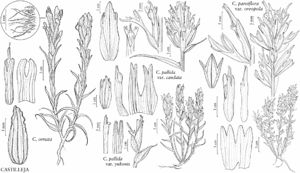Castilleja ornata
Proc. Amer. Acad. Arts 44: 571. 1909.
Herbs, annual, 1.7–3.5(–5) dm; with a thin taproot or fibrous root system. Stems solitary or few to several, erect or ascending, often branched low on stem, unbranched distally, hairs appressed or retrorse, medium length, soft, eglandular, mixed with shorter stipitate-glandular ones. Leaves green or purple-tinged, proximal forming a rosette, linear-lanceolate to oblong or oblanceolate, 2–4 cm, not fleshy, clasping, margins wavy, sometimes plane, involute, 0-lobed, apex acuminate, acute, or obtuse. Inflorescences 3–24 × 1.5–3 cm; bracts proximally green, distally white, sometimes very pale yellow, often aging dull pink or dull red-purple, spatulate, 0-lobed, sometimes seeming lobed due to wavy margins, apex obtuse to rounded. Calyces green throughout or distal margin white aging pink, 15–17 mm; abaxial and adaxial clefts 6–14 mm, 35–45% of calyx length, deeper than laterals, lateral 0(–0.7) mm, 0(–5)% of calyx length; lobes short-triangular, abaxial segments longer than adaxials, apex acute to obtuse or rounded. Corollas slightly curved, 22–24 mm; tube 10–13 mm; beak exserted, adaxially green, 5–10 mm; abaxial lip pale greenish, reduced, pouches 3, 0.5–1.5 mm, 5–10% as long as beak; teeth slightly incurved, reduced, pale greenish to white, 0.3–0.7 mm. 2n = 24.
Phenology: Flowering Jul–Sep.
Habitat: Seasonally damp ground, dry or sandy grasslands.
Elevation: 1500–2100 m.
Distribution
N.Mex., Mexico (Chihuahua, Durango).
Discussion
Castilleja ornata is known from Chihuahua and northern Durango, Mexico, but much of its seasonally moist grassland habitat is now altered by grazing or agriculture, and there are no recent sightings of the species south of the United States border. There is a recently discovered population in southwestern New Mexico, in the southern Animas Valley of Hidalgo County. While very rare, C. ornata lacks federal protection. The small Animas Valley population is the last known extant occurrence, and this population was reduced to two individuals in a census conducted in 2017 (D. Roth, pers. comm.). The species appears to be critically endangered globally and in need of conservation management.
The inflorescences of Castilleja ornata have pale greenish bracts with white apices when young, but the apices often become pale pink to dull reddish with age. Its pubescence, wavy-margined leaves, and unusual bract color also distinguish C. ornata. Castilleja exserta and C. minor are the only other annual paintbrushes in New Mexico and differ from C. ornata by the color of their floral bract apices, which are usually pink to red-purple in C. exserta and bright red in C. minor.
Selected References
None.
